Gb7-14 has a
hau tea
with
mata in
both
directions -
it marks a
pivotal
(Janus) point. It
was at the
Belly of the
Fish (Al
Batn Al Hūt,
β
Andromedae).
The Belly of
the Fish
ought to be
similar to
the Belly of
the Sun.
Perhaps it
indicated the
birth place
of Mother
Earth.
A navel is
at the
belly.
 |
 |
 |
 |
 |
 |
| Gb7-12 (193) |
Gb7-13 |
Gb7-14 |
Gb7-15 |
Gb7-16 |
Gb7-17 (427) |
| JANUARY 30 |
31 |
FEBRUARY 1 |
2 (33) |
3 |
4 (400) |
| no star listed (14) |
1h (15.2) |
Al Batn Al Hūt-26 / Revati-28 / 1-iku-1 |
ν Phoenicis (17.4), κ Tucanae (17.6) |
no star listed (18) |
Adhil (19.3) |
| β Phoenicis (15.1), υ Phoenicis, ι Tucanae (15.6), ζ Phoenicis (15.7) |
MIRACH, Keun Nan Mun (16.0), ANUNITUM (16.5), REVATI (16.9) Regulus
|
| April 4 |
5 (460) |
6 |
7 |
8 |
9 (99) |
| 'March 8 |
9 |
10 |
11 (*355) |
12 |
13 (72) |
| NAKSHATRA DATES: |
| AUGUST 1 |
2 |
3 (*135) |
4 |
5 |
6 (218) |
| 13h (197.8) |
Apami-Atsa, ψ Hydrae (198.5) |
Al Dafīrah (199.4) |
σ Virginis (200.4) |
γ Hydrae (201.0), ι Centauri (201.4) |
Al Simāk-12 / Chitra-14 / Horn-1 / Sa-Sha-Shirū-20 |
| ξš Centauri (197.1), ξ˛ Centauri (197.9) |
Mizar (202.4), SPICA, Alcor (202.7) Sadalmelik
|
| October 4 |
5 |
6 |
7 (280) |
8 |
9 |
| 'September 7 (250) |
8 |
9 |
10 (*173) |
11 |
12 |
Al
Batn
is
probably from
*bayt
('house'):
| Egyptian house |
 |
Phoenician beth |
 |
Greek beta |
Β (β) |
|
... Like the names of most other Greek letters, the name of beta was adopted from the acrophonic name of the corresponding letter in Phoenician, which was the common Semitic word *bayt ('house').
In the system of Greek numerals beta had a value of 2. |
Thus Mago
in
Gb7-13
was
pregnant.
| 6. The imaginary central vertical line in hau tea does correspond to an imaginary line on Easter Island. As has been suggested the vertical line at right in the glyph probably represents the horizon in the east and the vertical line at left the horizon in the west, while the central one cannot be a horizon - there is no more parallel horizon:

Instead the central line is imaginary - shown by it being a separate element not connected with the rest of the glyph.
The center of the island is Anakena with the king. As noted in Barthel 2, also Vinapu is located in the middle, and an imaginary line can be drawn between these two central places:
'... On the 'second list of place names', Hanga Te Pau is called 'the middle (zenith) of the land' (he tini o te kainga). This may refer to a line bisecting the island... Vinapu and Anakena were calendary opposites ...'
Astronomers observe stars rising in the east and setting in the west, but they also observe them when they are passing right overhead. A kind of structure with 3 parallel lines is used for observing stars.
Hamlet's Mill:
'It should be stated right now that 'fire' is actually a great circle reaching from the North Pole of the celestial sphere to its South Pole ...'
At noon sun stands high and blazing, and the great 'fire' circle noted in Hamlet's Mill presumably is equal to the imaginary line through Anakena southwards to Vinapu. Sun moves from east to west, but the imaginary line is oriented the other way, from north to south, and therefore it is a line marking time and a line connected with the moon. The name hau tea is quite in order, it is primarily a female glyph type, a glyph type for housing new life. |
| 'The traditions show that the residences of the king were fairly flexible. The building of new houses was obviously the result of (male) births in the royal family. In each case, the house that was built last is left to the newborn son and his mother, together with a specific servant, while the king has a new and separate residence constructed for himself. Ms. E clearly demonstrates this procedure, which was followed in spite of Hotu Matua's quarrel with Vakai. In the text four houses are associated with the four sons. Later residences of Hotu Matua have different names and are the scenes of different activities. The four sons and the four houses are coordinated as shown in Table 10:
|
TABLE 10 |
| 1. Hare Tupa Tuu |
1. Tuu Maheke |
| 2. Hare Pu Rangi |
2. Miru (Te Mata Nui) |
| 3. Hare Moa Viviri |
3. Tuu A Hotu Iti (Te Mata Iti) |
| 4. Hare Moa Tataka |
4. Tuu Rano Kau |
The first house is located in Oromanga. It is the residence (maara noho) of the immigrant king that was envisioned in the dream voyage and sought by the explorers. The second and the third houses are also said to have been in Anakena, a short distance away ('60 meters', according to my informant). Supposedly, the same is true of the fourth house. It is difficult to translate the names of the houses. Below is an incomplete list of possible translations:
| tupa tuu |
'the crab has arrived'; 'the litter has arrived'; 'a stone tower has been erected' |
| pu rangi |
'the shell trumpet calls'; 'hole in the sky'; 'royal tribe' |
| moa viviri |
'rooster who turns around'; 'energetic son' |
| moa tataka |
'the roosters form a circle'; 'son who departs' (? RAR.)' or 'son who doesn't fulfill the expectations (? MAO.)'; 'son who unites many around himself' |
It appears that the names of the houses of the four sons are arranged in pairs and express some characteristics of the descendents who live in them. Only Ms. E shows this type of connection.
Arturo Teao mentions some of the names of the houses, but he does not associate them with the respective sons. According to him, 'Hare Tupa Tuu' is the first residence of the king after the immigration (TP:44). After the quarrel with Vakai, Hotu Matua moves to 'Hare Moa Viviri' and later to 'Hare Moa Tataka'.
The second and the third residences are associated with successful agricultural activities (TP:51). Then this source deviates from Ms. E: the fourth residence is 'Te Ngao O Te Honu', and the island king is accompanied to this place by a small adopted boy. The fifth residence is 'Taro Tataka'. In each case, the king is followed by Vakai.
According to Leonardo Pakarati, 'the neck of the turtle' was the birthplace of the youngest son, Tuu Hotu Iti. He has no information about the place called 'taro is standing in a circle'.
Ms. E lists as the last residences 'Aro Huri' (for three months), 'Maunga Pua' (for three months), and 'Tavarivari A Umi'. As already mentioned, 'Aro Huri' is a slight elevation in the flank of Maunga Koua, and it is the fourth point of demarcation along the border of the tabooed royal district. 'Maunga Pua' is the old name for the mountain now called 'Maunga Koua'. It is the fifth point of demarcation along the border of the royal precinct. The last name could not be located.' (Barthel 2) |
We seem to be on firm ground here. Births are connected with new houses. Implicitly we can read this also in the myth about Fakataka (Making a Cycle) and Taetagaloa (Not Tagaroa). Furthermore, Nuku Kehu created houses from the overturned canoes (after the royal children Tuu Ma Heke and Ava Rei Pua Poki had been born):
... Fakataka swims and swims, reaching another land. She goes there and stays on the upraised reef in the freshwater pools on the reef, and there delivers her child, a boy child. She gives him the name Taetagaloa. When the baby is born a golden plover flies over and alights upon the reef. (Kua fanau lā te pepe kae lele mai te tuli oi tū mai i te papa). And so the woman thus names various parts of the child beginning with the name 'the plover' (tuli): neck (tuliulu), elbow (tulilima), knee (tulivae). They go inland at the land. The child nursed and tended grows up, is able to go and play. Each day he now goes off a bit further away, moving some distance away from the house, and then returns to their house ...
... Nuku Kehu covered (kehu) the overturned canoe hulls of the king and the queen ...
Nicely the expression tupa tuu was above translated not only as 'the litter has arrived' but also as 'the crab has arrived'. I can imagine a crab (crib, cradle) in Gb7-18:
 
 |
 |
 |
 |
| Gb7-18 |
Gb7-19 (200) |
Gb7-20 (430) |
Gb7-21 |
| FEBRUARY 5 (36) |
6 |
7 (403) |
8 (*324) |
| Ksora (20.1), ω Andromedae (20.6), γ Phoenicis (20.8) |
δ Phoenicis (21.5) |
υ Andromedae (22.9) |
Achernar (23.3), χ Andromedae (23.6), τ Andromedae (23.9) |
| April 10 (100) |
11 (466) |
12 |
4-13 |
| 3-14 (73) |
'March 15 |
16 (*360) |
17 |
| NAKSHATRA DATES: |
| AUGUST 7 |
8 (*140) |
9 |
10 (222) |
| 71 Virginis (203.6) |
no star listed (204) |
Heze (205.0), Southern Pinwheel Galaxy (205.7) |
ε Centauri (206.3), κ Oct. (206.4) |
| October 10 |
11 |
12 (285) |
13 |
| 'September 13 (256) |
14 (*177) |
15 |
16 |
 |
 |
 |
 |
 |
| Gb7-22 |
Gb7-23 (204) |
Gb7-24 |
Gb7-25 |
Gb7-26 (436) |
| FEBRUARY 9 |
10 |
11 (42) |
12 (408) |
13 (*329) |
| τ Ceti (24.7) |
no star listed (25) |
ANA-NIA |
Al Sharatain-1 / Ashvini-1 / Bond-16 / Mahrū-sha-rishu-ku-2 |
ι Arietis (28.0), λ Arietis (28.2), υ Ceti (28.8) |
| χ Ceti (26.1), POLARIS, Baten Kaitos (26.6), Metallah (26.9) |
Segin, Mesarthim, ψ Phoenicis (27.2), SHERATAN, φ Phoenicis (27.4) |
| April 14 |
15 |
16 (471) |
17 (107) |
18 (*393) |
| 'March 18 |
19 |
20 |
0h |
22 |
| NAKSHATRA DATES: |
| AUGUST 11 |
12 |
13 (*145) |
14 |
15 (227) |
| no star listed (207) |
τ Bootis (208.2), Benetnash (208.5), ν Centauri (208.7), μ Centauri, υ Bootis (208.8) |
no star listed (209) |
Muphrid (210.1), ζ Centauri (210.3) |
φ Centauri (211.0), υš Centauri (211.1), υ˛ Centauri (211.8), τ Virginis (211.9) |
| October 14 |
15 |
16 |
17 (290) |
18 |
| 'September 17 (260) |
18 |
19 |
20 |
21 (*184) |
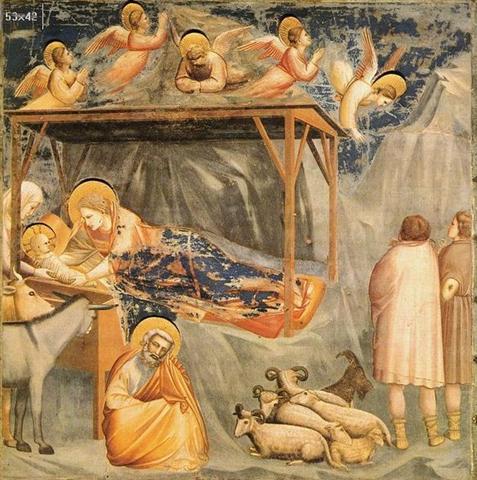
... The winnowing-fan (λίκνον [líknon], also meaning a 'cradle') featured in the rites accorded Dionysus and in the Eleusinian Mysteries: 'it was a simple agricultural implement taken over and mysticised by the religion of Dionysus', Jane Ellen Harrison remarked. Dionysus Liknites ('Dionysus of the winnowing fan') was wakened by the Dionysian women, in this instance called Thyiades, in a cave on Parnassus high above Delphi; the winnowing-fan links the god connected with the mystery religions to the agricultural cycle, but mortal Greek babies too were laid in a winnowing-fan. In Callimachus' Hymn to Zeus, Adrasteia lays the infant Zeus in a golden líknon, her goat suckles him and he is given honey ...
Notice the dark goat head behind the group of 6 sheep. This goat head is also at the end of the panel below, above the empty urn:
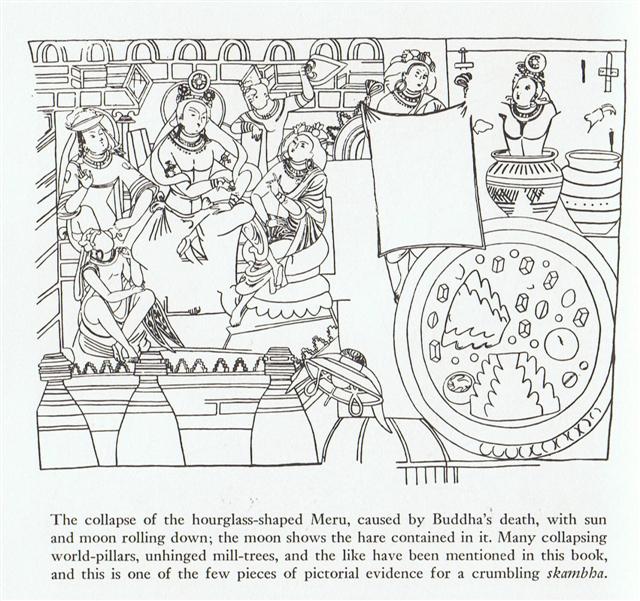
... At the beginning of side a, at the Door of the Goat (Haedus I and II), 'death' seems to have been described as necessary before 'birth' (hanau), at least for gods and kings (ariki) ...
... The sun at noon is the sun declining; the creature born is the creature dying ...
 |
 |
 |
 |
| Ga1-11 |
Ga1-12 |
Ga1-13 |
Ga1-14 |
| Haedus II (75.9) |
5h (76.1) |
μ Aurigae, μ Leporis (77.6) |
ĸ Leporis (78.0), RIGEL (78.1), Flaming Star (78.2), Capella (78.4), ο Columbae, τ Orionis (78.8)
Thuban
|
| ε Leporis (76.0), CURSA (76.4), λ Eridani (76.7) |
| Cursa = λ Eridani and Rigel = β Orionis. |
| June 4 |
5 |
6 (157 = 314 / 2) |
7 |
| 'May 8 (128) |
9 |
10 (*50) |
11 |
| "April 24 (*34) |
25 |
26 (116 = 4 * 29) |
27 |
| 17h (258.7) |
Mula-19 |
Nodus I (260.0), π Herculis (260.7), Ras Algethi (260.8) |
Sarin (261.0), ο Ophiuchi (261.4)
Alrisha
|
| no star listed (258) |
Sabik (259.7), η SCORPII (259.9) |
| December 4 |
5 (*259) |
6 (340) |
7 |
| 'November 7 |
8 |
9 (*233) |
10 |
| "October 24 |
25 |
26 (*219) |
27 (300) |
The death skull of 'the old goat' was necessary for creating new life. ... Up to the present time, fertility spells for fowls have played an important role. Especially effective were the so-called 'chicken skulls' (puoko moa) - that is, the skulls of dead chiefs, often marked by incisions, that were considered a source of mana. Their task is explained as follows: 'The skulls of the chiefs are for the chicken, so that thousands may be born' (te puoko ariki mo te moa, mo topa o te piere) ... As long as the source of mana is kept in the house, the hens are impregnated (he rei te moa i te uha), they lay eggs (he ne'ine'i te uha i te mamari), and the chicks are hatched (he topa te maanga). After a period of time, the beneficial skull has to be removed, because otherwise the hens become exhausted from laying eggs. 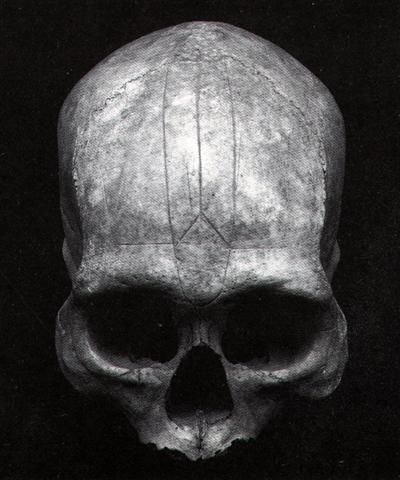
From
δ (Ksora) at
the 4th
and last
(death) corner of
the old
queen to ι
Arietis
there were 8
dark nights.
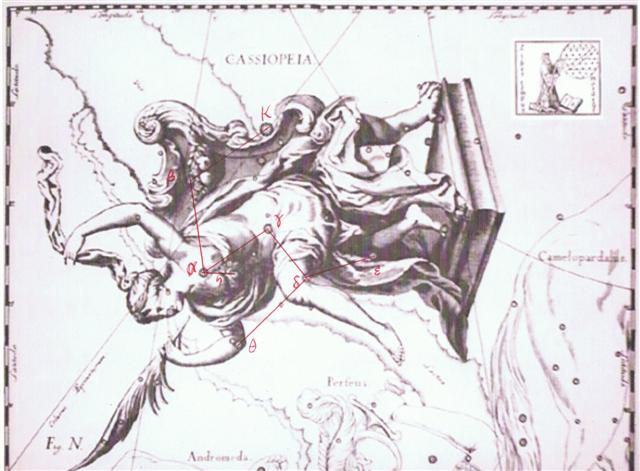
... Thus number 4 should hit hard upon our consiousness, it is not an arbitrary number. In Eastern cultures it is still so: ' Interestingly, since another meaning of shi is 'death', the number 4 is considered unlucky. (For example, the floor numbering in hotels sometimes jumps mysteriously from 3 to 5; it's also considered unlucky to give four of something as a present.)' ...
Makemake
was probably
the creative underground
period
before Venus
returned as
newborn
Morning
Star.
| Egyptian arm |
 |
Phoenician yodh |
 |
Greek iota |
Ι (ι) |
|
Yodh is thought to have originated with a pictograph of a hand, ultimately deriving from Proto-Semitic *yad-. It may be related to the Egyptian hieroglyphic of an arm. (Wikipedia)
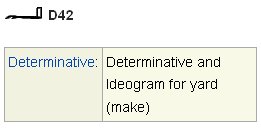
|

"... Thereupon the king [Hotu A Matua] asked, 'Why did the land sink into the sea?' 'It was lifted up by Uvoke with a (mighty) pole. From there, where it was lifted, from Teavaka, (Uvoke came) to Te Ohiro, then to Te Pito O Henua. It was Puku Puhipuhi where the pole of Uvoke broke. The hole (?) is the size of the pole. The pole came from above.' The king said to Teavaka, 'It was not the pole (of Uvoke), stranger, that did this. It was a bolt of lightning (or, the impact of a meteor?) of Makemake which you have seen!' ..." (The Eighth Island, p. 4.)
The
'bolt of
lightning
of
Makemake'
sounds
like a
description
of the
effects
of
kava
drinking:
 |
 |
 |
 |
 |
| Gb5-21 (145) |
Gb5-22 |
Gb5-23 |
Gb5-24 |
Gb5-25 (378) |
| MARCH 30 (*9) |
31 (*10) |
APRIL 1 |
2 (457) |
3 (93) |
| πš Orionis (73.0), ο˛ Orionis (73.4), Hassaleh (73.6), π6 Orionis (73.9) |
Almaaz (74.7), Haedus I (74.8) |
Haedus II (75.9) |
5h (76.1) |
μ Aurigae, μ Leporis (77.6) |
| ε Leporis (76.0), Cursa (76.4), λ Eridani (76.7) |
| June 2 (153) |
3 |
4 (520) |
June 5 |
6 (157) |
| 'May 6 (*46) |
7 |
8 (128) |
*414 |
10 (*50) |
| "April 22 (*32) |
23 |
114 = 6 * 19 |
25 |
26 (*36) |
| NAKSHATRA DATES: |
| SEPTEMBER 29 |
30 (273) |
OCTOBER 1 |
2 |
3 |
| κ Ophiuchi (256.2), ζ Arae (256.5), ε Arae (256.8), Cujam (256.9) |
no star listed (257) |
17h (258.7) |
Mula-19 |
Nodus I (260.0), π Herculis (260.7), Ras Algethi (260.8) |
| no star listed (258) |
Sabik (259.7), η SCORPII (259.9) |
| December 2 (336) |
3 |
4 |
5 |
6 (340) |
| 'November 5 (*229) |
6 |
7 |
8 |
9 (313) |
| "October 22 (295) |
23 (*216) |
24 |
25 |
26 (299) |
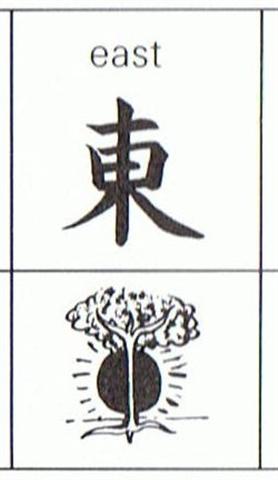
... Usually explained incorrectly as sun rising behind trees to indicate dawn and thus east, an error of many centuries' standing. Very old forms reveal that is is a tied sack with a pole thrust through to facilitate carrying, and in that regard it is in the same group as bundle and select / open bundle ...
The error seems to stem from a reasonably early form in which the ends of the binding have become separated from the sack, thus suggesting the early form of tree / wood. It is not clear whether this is a simple copying error, an attempt to refer to the wooden nature of the pole, or a mistaken interpretation of the elements as sun and tree. In any event, from an early stage [it] was borrowed phonetically to express east. Some scholars feel that it also lent an idea of thrusting through (i.e. the pole through the binding) and thus by extension suggested the sun thrusting up through the horizon, giving dawn and hence east ...
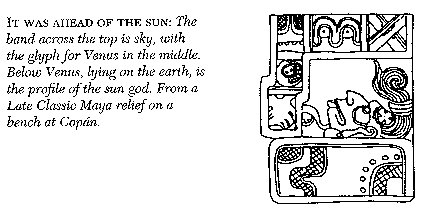
|



















